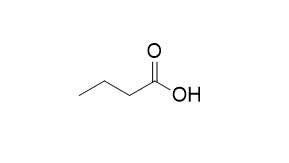Butyric acid
Butyric acid, a potent inducer of erythroid differentiation in cultured erythroleukemic cells, it induces apoptosis in human hepatic tumour cells. Butyric acid causes morphological changes in cultured chondrocytes through alterations in the extracellular matrix.
Inquire / Order:
manager@chemfaces.com
Technical Inquiries:
service@chemfaces.com
Tel:
+86-27-84237783
Fax:
+86-27-84254680
Address:
1 Building, No. 83, CheCheng Rd., Wuhan Economic and Technological Development Zone, Wuhan, Hubei 430056, PRC
Providing storage is as stated on the product vial and the vial is kept tightly sealed, the product can be stored for up to
24 months(2-8C).
Wherever possible, you should prepare and use solutions on the same day. However, if you need to make up stock solutions in advance, we recommend that you store the solution as aliquots in tightly sealed vials at -20C. Generally, these will be useable for up to two weeks. Before use, and prior to opening the vial we recommend that you allow your product to equilibrate to room temperature for at least 1 hour.
Need more advice on solubility, usage and handling? Please email to: service@chemfaces.com
The packaging of the product may have turned upside down during transportation, resulting in the natural compounds adhering to the neck or cap of the vial. take the vial out of its packaging and gently shake to let the compounds fall to the bottom of the vial. for liquid products, centrifuge at 200-500 RPM to gather the liquid at the bottom of the vial. try to avoid loss or contamination during handling.
Front Cell Dev Biol.2021, 9:588093.
Pak J Pharm Sci.2019, 32(6)
Korean J. Medicinal Crop Sci.2021, 29(6):425-433
FEBS Lett.2021, 595(20):2608-2615.
Nutrients.2024, 16(19):3266.
ACS Omega.2024, 9(12):14356-14367.
Invest New Drugs.2017, 35(2):166-179
Molecules.2024, 29(6):1240.
Plants (Basel).2023, 12(5):1120.
J Ethnopharmacol.2020, 269:113752.
Related and Featured Products
Cell, 1975, 5(3):319-322.
Butyric acid, a potent inducer of erythroid differentiation in cultured erythroleukemic cells.[Pubmed:
1056809]
Butyric acid is an unusually potent inducer of erythroid differentiation in cultured erythroleukemic cells. It is effective at one hundredth the concentration required of dimethylsulfoxide, a most effective inducing agent.
METHODS AND RESULTS:
Studies using a variety of analogues and metabolites suggest that the structural features of Butyric acid are rather stringently required for induction. This effect is considered in view of the fact that Butyric acid is a naturally occurring fatty acid, is effective in relatively low concentrations, and is widely used to form derivatives of cAMP.
Journal of Cellular Physiology, 1989, 138(1):197-204.
Butyric acid causes morphological changes in cultured chondrocytes through alterations in the extracellular matrix.[Pubmed:
2910883]
Butyric acid induces characteristic changes in the morphology of chick embryo chondrocytes.
METHODS AND RESULTS:
Chick embryo chondrocytes when cultured in the absence of butyrate exhibit a spherical morphology and synthesize cartilage-specific chondroitin sulfate proteoglycan (CSPG). When these cultures are initiated and maintained in the presence of Butyric acid, chondrocytes exhibit a mesenchymal morphology, a 90% reduction in the synthesis of CSPG, and a 75% reduction in DNA synthesis. The reduced synthesis of CSPG and DNA was shown not to be dependent on the morphological change. Chondrocytes require CSPG in order to express a spherical morphology, since including chondroitinase ABC in the culture media caused the cells to spread. In addition, the treatment of chondrocytes with purified CSPG prior to culture in media containing Butyric acid resulted in spherical cells. The butyrate-induced spreading was shown to require either serum or fibronectin and could be prevented with antiserum against chick cell-surface fibronectin (cFn). Cell-surface fibronectin, which was present on both spherical and flattened chondrocytes, organized into fibrils beneath cells which spread. Increased fibronectin synthesis was not responsible for the butyrate-induced morphological change.
CONCLUSIONS:
From this evidence, it is concluded that the mechanism by which butyrate alters the morphology of these cells in culture involves inhibiting CSPG synthesis, thus preventing CSPG accumulation in the extracellular matrix (ECM). The absence of CSPG in the ECM allows fibronectin to mediate spreading of chondrocytes in culture.
Journal of Oleo ence, 1999, 48(4):331-337,364.
Simple Determination of Fatty Acid Compositions of Edible Oils by Lipase Hydrolysis and High-Performance Liquid Chromatography.[Reference:
WebLink]
METHODS AND RESULTS:
High-performance liquid chromatography (HPLC) using a 205 nm UV detector was evaluated for usefulness in determining fatty acid compositions, especially unsaturated fatty acid compositions, of edible oils such as perilla, soybean and safflower oils, which mainly consist of triglycerides that contain mono and polyunsaturated fatty acids. Fatty acids were obtained by lipase-hydrolysis followed by petroleum ether extraction. Sample fatty acids were analyzed by HPLC without conversion to the derivatives. Butyric acid served as the internal standard for determination of fatty acids. The results showed close agreement with those of GC.
CONCLUSIONS:
The present method is applicable to the simple determination of fatty acid compositions, especially unsaturated fatty acid compositions, of edible oils without degradation due to heating and/or the oxidative deterioration of unsaturated fatty acids.



